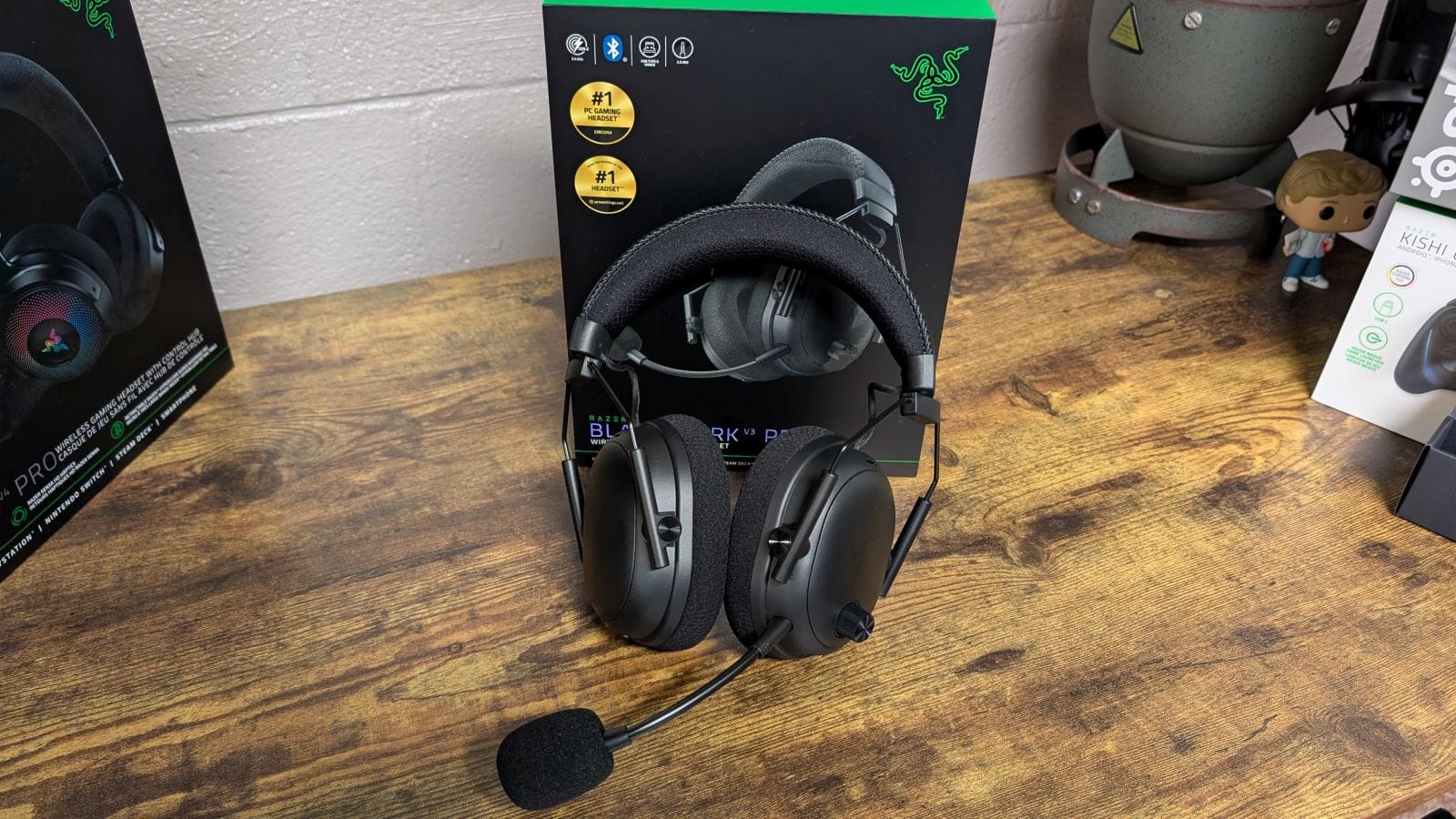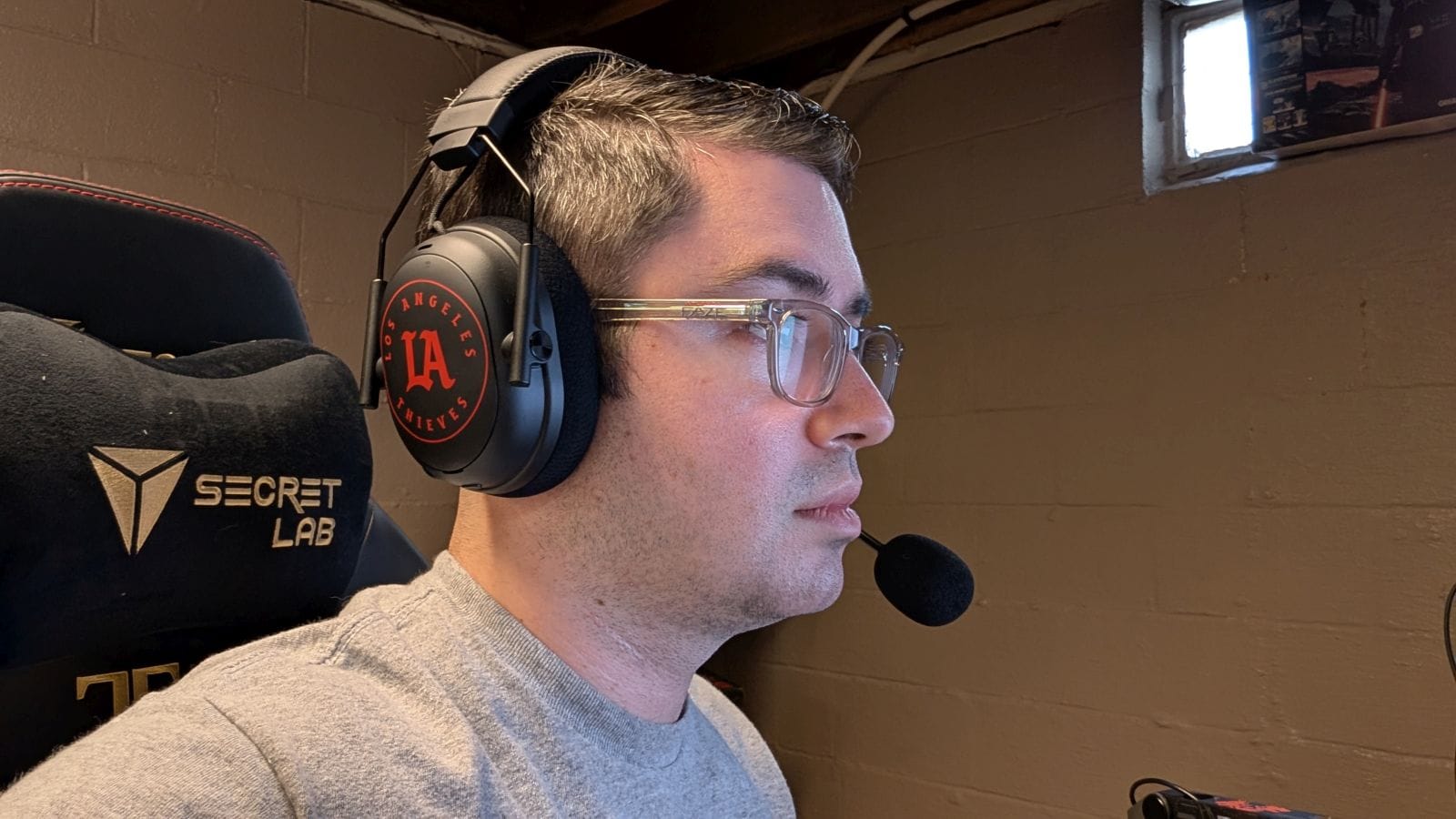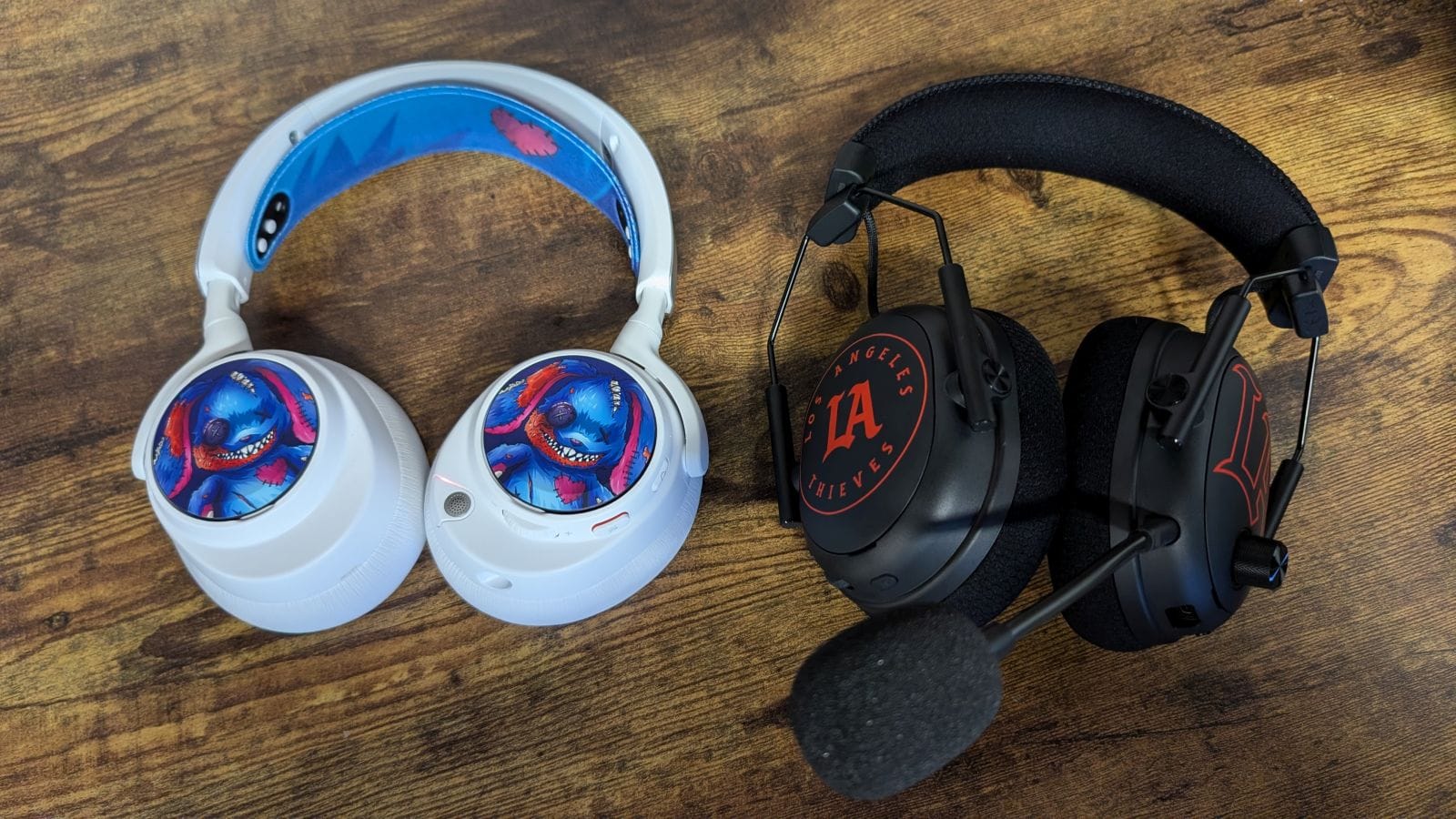
If you remember from last year, I took a look at Razer’s attempt at bringing console gamers into the fold with their BlackShark V2 Pro headset. It was a great headset too, with great audio, a fantastic microphone, and more. That said, there were a few absent features that surprised me coming from a company as prestigious as Razer. After talking with the team and spending time with their newest model, the V3 Pro, I’m happy to say that they’ve not only addressed what I brought up, but introduced even more functionality I hadn’t even thought of.
Opening the box, you’ll find the Razer BlackShark V3 Pro wireless headset, their own Hyperspeed Wireless Gen-2 dongle (the Xbox model includes the security chip necessary), a detachable microphone, a USB-C cable, and a 3.5mm cable with USB-C adapter. The USB-C cable is a nice braided one about five feet long, and I appreciate the addition of the 3.5mm cable. This allows you to use your headset passively if you forget to charge it; a wonderful extra for those who use their headset a lot.
Something that always blows me away with Razer gear is their sleek design. The BlackShark V3 Pro is no different, sporting that epic army helicopter pilot-style that looks about as professional as it gets. Razer has done some tweaking, building in a swivel joint that allows it to sit on your ears better. The combinations of plastic, metal, fabric, and foam all make for a sheen to the BlackShark V3 Pro that alone makes it seem like the best headset in the room.
Adorning the earcups are your controls, and these have also been reworked a bit. I mentioned in my review for the BlackShark V2 Pro for consoles that there wasn’t a lot there, and the Razer design team has taken that to heart. Where the textured volume knob returns with the detachable mic, mute button, power button, and USB-C port on the left, the right has gotten a bit more attention. The profile button returns, but with two friends: an ANC button, and an additional roller control.
While it’s not a tremendous amount more, the extras are the right call. We’ll talk about ANC more later, but that’s a feature that needs a button. The profile button also allows you to swap between connectivity with a double tap, letting you use it for swapping between Bluetooth, the Hyperspeed dongle, and simultaneous modes. The roller wheel has several functions, including game chat balance, mic sidetone, and more. Razer has even added a footstep sound level scaling capability that works with your chosen game profile, which is quite nifty for those playing competitive games.

As soon as you put the BlackShark V3 Pro on, there’s something different about it. The V2 Pro was still comfortable, there’s no denying it. But, even with a weighty new version (.81lbs compared to .71lbs), the fit is better. Some of this has to be attributed to a few tweaks to the frame, but special praise has to be given to the aforementioned swivel joint that allows the BlackShark V3 Pro to conform to your head shape. Playing over long gaming sessions has been very comfortable, with the fabric and leatherette ear cushions resting with a nice seal around my ears.
That seal is for more than just comfort, adding passive noise cancellation to the formula. If that’s not enough for you, the new active noise cancellation is one of my favorite things about the BlackShark V3 Pro. I’m a huge fan of ANC, which is a feature that can instantly win me over on a headset. Razer’s implementation goes hybrid, with not as strong of an active component, but one that works very well. They’ve also introduced an ambient mode for those who want to be more aware but also receive some of the ANC benefits. I always base my grade of ANC on whether or not I can hear my air conditioning downstairs since I’m close to it at my desk. Given the BlackShark V3 Pro blocks it out almost perfectly, this is an easy A+.
Once you block out the outside, it’s time to get new noise in. Razer has redesigned their signature drivers, with fresh TriForce Bio-Cellulose 50 mm Drivers powering the BlackShark V3 Pro. While I always test the sound out with Call of Duty, I wanted to mix things up a tad. Playing some Counter-Strike 2, I had the knowledge of where everything was happening on the map, simply via audio cues. It’s somewhat crazy to think I could close my eyes and be able to understand everything happening around me, almost like a “spider-sense”. Hearing each footstep and where it was coming from, and knowing where another player was firing his gun to reinforce that lane makes such a difference when you’re playing anything competitive.

This also makes its way to Call of Duty: Black Ops 6 and Warzone. Yeah, you’re not going to get away from my blathering about my favorite shooter. The biggest compliment I can give to the BlackShark V3 Pro is that I don’t feel at a disadvantage when using it over my daily headset which costs an extra hundred dollars. Given I’m the type to immediately know if COD doesn’t sound right, this goes to show how finely tuned the BlackShark V3 Pro is. My audio cues are on point, and as I play the more competitive modes of Black Ops 6, they need to be.
These audio cues in both Counter-Strike 2 and Black Ops 6 are enabled by excellent spatial sound that is curated by THX 7.1 on PC, Windows Sonic on Xbox Series consoles, and 3D Tempest Audio on PlayStation 5. THX’s solution can offer some incredible surround sound, assuming your game is on the list of supported titles for maximum effect. I’m not sure why, but because of Call of Duty’s HQ app, my Black Ops 6 doesn’t work through it (it’s supposed to), so I’m not sure how good the audio is. Even so, simply equipping the setting does make a difference in games, giving you intense and immersive sound as you play through your library. One of the coolest additions to THX’s spatial audio is the upgraded engine that gives more pinpoint locations to vertical cues, making it easier to tell if a sniper is on a rooftop for example.
Although the audio is crisp when I watch a show or listen to music, I wouldn’t say it redefines my experience. The highs and mids are great, with the bass being right above average. This is most noticeable when listening to metal music or some techno, with the thumping needing a volume boost to be heard at its best. I do have to give Razer a lot of credit for how well these drivers handle my detail vs volume quandary. Some headsets overvalue volume and miss the precise detail you should want in your sound. For games, Razer competes with the best. With music and film, they’re good, but not in the top tier.

An area where they are certainly in the top tier is battery life. I think I may have charged these twice in the time I’ve had them, and while I haven’t been gaming as much as usual due to some outside elements, that’s pretty awesome. Razer estimates you can get about seventy hours of battery life on PC, with console coming in at forty-eight hours due to technical limitations. I’ve gotten at least that much on my end, and if you find yourself somehow running low, you can still use the headset passively through the included 3.5mm cable.
Speaking of that connection, Razer building in so much versatility has to be commended. Razer’s Hyperspeed dongle is one of the fastest on the market, offering only 10ms of latency in what you hear. This is the fastest out there, and gives you nearly imperceptible one-for-one audio performance. If you’re like me and love a good Bluetooth connection, that’s available too. Bluetooth 5.3 capability isn’t like the previous models either, with simultaneous streaming alongside the 2.4GHz. Being able to listen to music from my phone or even just picking up the phone to answer my wife while gaming is a blessing, and with the profile button you can also choose if you want to only focus on the game via a specific mode.
I’m happy with the microphone, even if it’s simply at the top of the pyramid when it comes to gaming headsets. The HyperClear Full Band 12 mm mic isn’t going to fool anyone into thinking you are using a streaming mic – my buddies could immediately tell the difference – but it’s clear and largely absent of the buzzing that usually accompanies headset microphones. I felt similarly about the BlackShark V2 Pro, so it’s nice that Razer didn’t see the need to change what worked.
Razer has brought plenty to the table via their Synapse app, which is also coming to Xbox natively, along with a phone app to make adjustments. It’s not the most intensive studio I’ve seen available for hardware, but it’s probably the second most impressive. There’s a bit of EQ you can handle in here, along with making your own settings that can be loaded to the profiles of your headset. Razer has also added a few new esports into the equation alongside the ones from the BlackShark V2 Pro, bringing in pros to help tune the EQ to be exactly what you’ll want when playing said game. Outside of that, you can enable ultra-low latency from the Hyperspeed dongle, adjust your mic’s output (which is important), sidetone, and several power settings. I’d love to see Razer eventually put EQ sharing in, allowing the community to build presets to share around.
Here’s a great bonus you may not have expected: replaceable ear plates. I forgot about this feature until they recently showed up before the review period was up, and they are super easy to change out. The ear plates are magnetic and pop right off when pulled, with your new ones sticking right in place. I have some sweet LA Thieves ones on this headset, but Razer will be offering plenty of other designs in the future, especially the esports brands they represent. Great choice by Razer to add some style in the midst of all this substance.
Razer BlackShark V3 Pro wireless headset
Excellent
Razer has leveled up with the BlackShark V3 Pro. I already really liked the V2, but this sequel has improved in every conceivable way, and even in ones I hadn’t thought about. Delivering awesome sound through this comfy and iconic design, offering incredible active noise cancellation with a great microphone, and topping it all off with terrific battery life makes for a killer package. Synapse’s upgrades and replaceable ear cushion plates are just icing on an already epic cake that is the Razer BlackShark V3 Pro wireless gaming headset.
Pros
- Outstanding sleek and comfortable design
- Finely tuned drivers delivering great spatial audio
- Fantastic active noise cancellation
- Simultaneous 2.4GHz and Bluetooth 5.3
- Loads of extras (wired connectivity, new EQs, additional controls on headset, etc)
Cons
- Music and film audio could use extra love
This review is based on a retail copy provided by the publisher.
